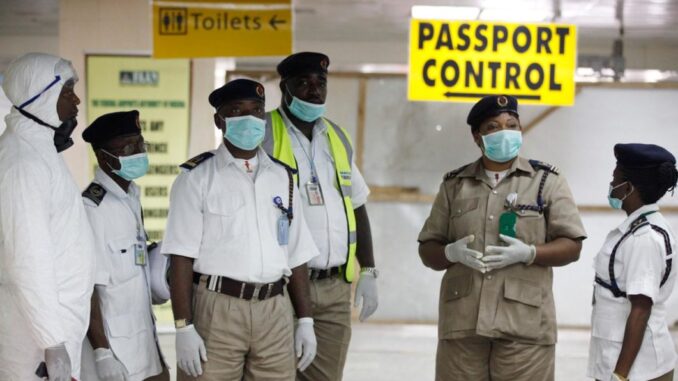
The response of Nigerian health authorities in strengthening surveillance at the nation’s points of entry to prevent the entry of Ebola disease from two African countries is appropriate. Underlying the response is the Nigerian experience in handling the outbreak in 2014. It is crucial, however, that nothing is left to chance to prevent the disease’ influx from Guinea and Congo (DCR).
At present, Port Health does not need to reinvent the wheel to check Ebola, because from the 2014 episode and the COVID-19 pandemic, there are structures in place to activate. Mounting surveillance and inspection of evidence of vaccination against various diseases at the nation’s borders should be continuous.
Since last month (February 27, 2021), Guinea has been facing the resurgence of the Ebola epidemic. For the first time since 2016, cases of haemorrhagic fever caused by the virus were recorded in the south-east of the country, leading to several deaths. The first victim, identified in the sub-prefecture of Gouécké, was a nurse who died at the end of January 2021. All the other cases are people who attended the funeral on February 1, 2021. As of March 7, 2021, a total of 18 cases, including 14 confirmed and four probable cases, had been identified; six people are currently hospitalized; the EVD outbreak has led to nine deaths, including five confirmed and four probable cases. Three persons recovered from the EVD. On March 6, 2021, 327 contacts were being followed up.
The Ebola outbreak is of particular concern to the Presidential Taskforce on COVID-19 (PTF), in view of efforts to contain COVID-19 pandemic, which has overstretched health facilities. Since Ebola virus was first identified in 1976, sporadic outbreaks have been reported in Africa; and the 2013–2016 West African Ebola outbreak, resulted in more than 11, 300 deaths. In 2014, more than 11, 000 died of the disease in Liberia, Guinea and Sierra Leone. Also, there was an outbreak in May 2017, while 2018 witnessed another outbreak in Bikoro Health Zone, Equateur Province.
On February 7, 2021, the Minister of Health of the Democratic Republic of the Congo (DRC) declared an outbreak of Ebola virus disease after a laboratory-confirmed case was detected. By February 14, 2021, four cases of EVD, including two deaths have been reported in the North Kivu province in the eastern part of DRC, where the 10th outbreak in the DRC of Ebola virus disease, which resulted in 3,470 cases including 2,287 deaths, was declared over in June 2020. This current outbreak constitutes the 12th outbreak of Ebola virus disease in the DRC.
In 2014, there was EVD outbreak in Nigeria and the outbreak remains unprecedented. The first case was confirmed in Lagos Nigeria on July 23, 2014 and spread to involve 19 laboratory-confirmed EVD cases. It was imported into the country by one Mr. Patrick Sawyer, an American-Liberian who arrived in Nigeria on July 20, 2014 on official duty. The patient died in Lagos within a few days of hospitalisation, but not before the virus had spread to Port Harcourt.
According to the World Health Organisation (WHO), “EVD is a severe, often fatal illness in humans. The virus is transmitted to people from wild animals and spreads in the human population through human-to-human transmission. The average EVD case fatality rate is around 50 per cent. Case fatality rates have varied from 25 per cent to 90 per cent in past outbreaks.”
The symptoms of EVD include fever, severe headache, muscle pain, weakness, fatigue, diarrhoea, vomiting, abdominal (stomach) pain, unexplained haemorrhage (bleeding or bruising). The symptoms may appear anywhere from 2 to 21 days after contact with the virus, with an average of 8 to 10 days. Many common illnesses can have these same symptoms, including influenza (flu) or malaria.
In a country where Ebola virus is widespread, people can protect themselves and prevent the spread of EVD by practising good hand hygiene through proper hand washing with soap and water or the use of an alcohol-based hand sanitizer. Furthermore, it is important to avoid contact with blood and body fluids such as urine, faeces, saliva, sweat, vomit, breast milk, semen, and vaginal fluids; items that may have come in contact with an infected person’s blood or body fluids; contact with bats and nonhuman primates or blood, fluids and raw meat prepared from these animals (bushmeat) or meat from an unknown source.
During the 2014 outbreak in Nigeria, swift implementation of public health measures helped the nation forestall a countrywide spread of this dreaded disease. The principal strategy was an incident management approach, which saw the identification and successful follow up of 894 contacts, out of which there were a total of 20 confirmed cases. Eight persons eventually died and 12 were nursed back to good health. The infected EVD cases were quarantined and treated. The cases brought out the best in Nigerian doctors. The Ministries of Health (FMoH) should sustain the interventions, surveillance and heavy investments that were introduced in 2014 to contain EVD.
Containing EVD lies in prevention essentially. Individuals should adopt prevention by practising hygiene, avoid the consumption of bush meat. In the main, health workers should maintain a high level of alert and observe universal precautions in handling all cases of fever. In the same vein, Nigerians should be more circumspect in their foreign trips.
END

Be the first to comment